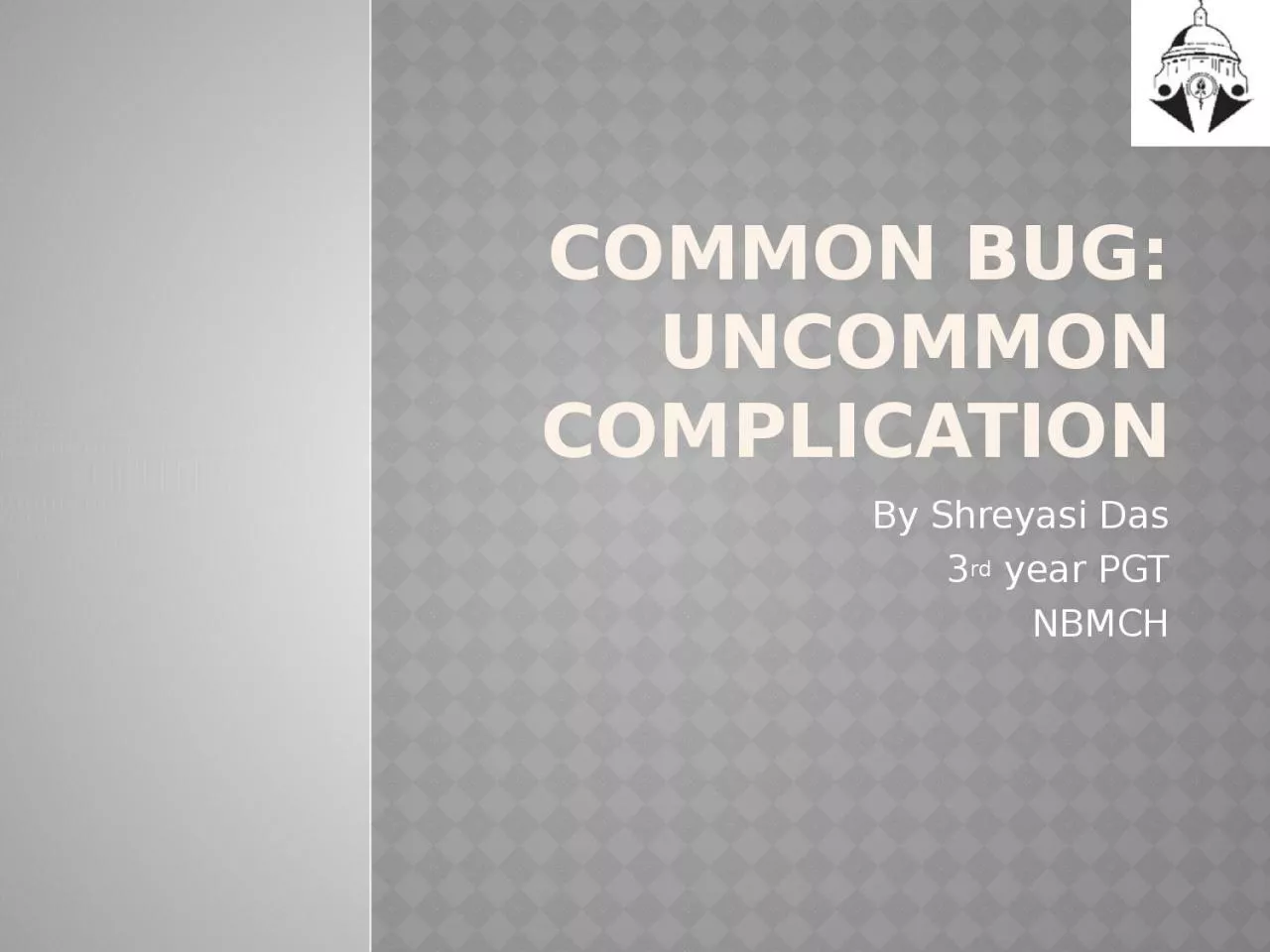

NBMCH COMMON BUG UNCOMMON COMPLICATION CASE PROFILE 5 years old female child presented with complaints of High grade continuous fever Pain abdomen 7 days Headache malaise and loss of appetite for the last 5 days ID: 1014902
Download Presentation The PPT/PDF document "By Shreyasi Das 3 rd year PGT" is the property of its rightful owner. Permission is granted to download and print the materials on this web site for personal, non-commercial use only, and to display it on your personal computer provided you do not modify the materials and that you retain all copyright notices contained in the materials. By downloading content from our website, you accept the terms of this agreement.
1. By Shreyasi Das3rd year PGTNBMCHCOMMON BUG: UNCOMMON COMPLICATION
2. CASE PROFILE5 years old female child presented with complaints of High grade continuous feverPain abdomen 7 daysHeadache, malaise and loss of appetite for the last 5 days.No any major illness in the past.Only child of her parents, born out of non-consanguinous marriage No significant birth history.Parents were healthyFamily lived in a pukka house with tube well as water supply Socio-economic status-Lower middle class according to Kuppuswamy scale 2019.
3. Conscious and alert ,but irritableTemp- 103oFB.P.- 92/64 mm of HgHR- 110/min Pallor-Present No cyanosis, icterus, clubbing or edemaLymph nodes -NPHeart sounds audible. No murmur or added sounds.Respiratory rate- 20/minChest- B/L clear with VBSAbdomen- mildly distended and tender, Liver span7 cm, spleen not palpableEXAMINATION
4. INITIAL INVESTIGATIONSCBCURINE R/EBlood C/S and Urine C/S- No growthTestResultHemoglobin7.8g/dlTotal WBC count7600/cummPlatelets20,000/cummTestResultAlbuminAbsentRed blood cellsNil
5. TestResultDengue ELISA NS1 AgNon-reactiveDengue IgM ELISANon-reactiveMalarial Parasite Dual AntigenNegativeScrub IGM ELISA POSITIVE 4.19
6. Oral Doxycycline started along with platelet transfusion Day 2 Fever subsided Day 3 Abdominal swelling reduced Day 5 Patient was clinically wellTREATMENT AND FURTHER PROBLEMS
7. Child was alert but irritable with periorbital puffiness.Temperature- 98oFNo pallor, cyanosis or icterus.Chest- B/L dullness on percussion and mild intercostal suction on inspiration.Heart sounds- muffled.Abdomen-Free fluid ++B/L pedal edemaB.P.- 118/80 mm of HgNo lymphadenopathy or splenomegaly.EXAMINATION On Day 8
8. TestResultHemoglobin8.9 g/dl (RBC normocytic and normochromic with severe anisopoikilocytosis)Total WBC count11,700/cummPlatelets1,00,000/cummUrea48mg/dlCreatinine0.6mg/dlTriglycerides306mg/dlSerum Cholesterol360mg/dlAlbumin2 gm/dlPT, APTT, INRWNLHIVNon-reactiveHBsAgNon-reactiveAnti-HCV antibodyNon-reactive
9. Urine R/E & M/EUSG of whole abdomen- Gross acsites with right sided pleural effusionEchocardiography- 3mm pericardial effusion, mostly posteriorly and mild pulmonary arterial hypertension.TestResultAlbumin3+Pus cells3-4/hpfGranular casts2-5/lpfAlbumin creatinine ratio906.8 mcg/mg creatinine
10. Started on prednisolone as first episode of Nephrotic SyndromeDidn’t respond at 4 weeks and showed presence of microscopic hematuria and persistent hypertensionUnderwent kidney biopsy
11. TestResultLight microscopy findingsTotal 8 glomeruli seen. 3 glomeruli segmentally sclerosed with adhesion. Rest 5 show mild mesangial matrix expansion with focal hypercellularity. Tubules- acute tubular injury with RBC casts. Intratubular polymorphonuclear cells noted.ImmunoflourescenceIgM shows podocytic uptake. IgG, IgA, C1q, kappa, lambda show no immune deposits.Final diagnosisFocal segmental glomerulosclerosisKidney biopsy findings
12. FSGS after an episode of scrub typhus infection has not been previously documented. Whole exome sequencing was done to search for genetic (primary) causes.Gene (Transcript)LocationZygosityInheritenceTBX18Exon 8HeterozygousAutosomal dominantINF2Exon 8HeterozygousAutosomal dominantNPHS1Exon 18HeterozygousAutosomal recessive
13. FINAL DIAGNOSISFocal Segmental Glomerulosclerosis in a genetically predisposed child within days after recovering from scrub typhus.
14. IssuesWas the patient completely cured from scrub typhus?Is nephrotic syndrome soon after related to scrub?How much is genetic predisposition responsible for kidney involvement?
15. LITERATURE SEARCH
16.
17.
18.
19. THANK YOU